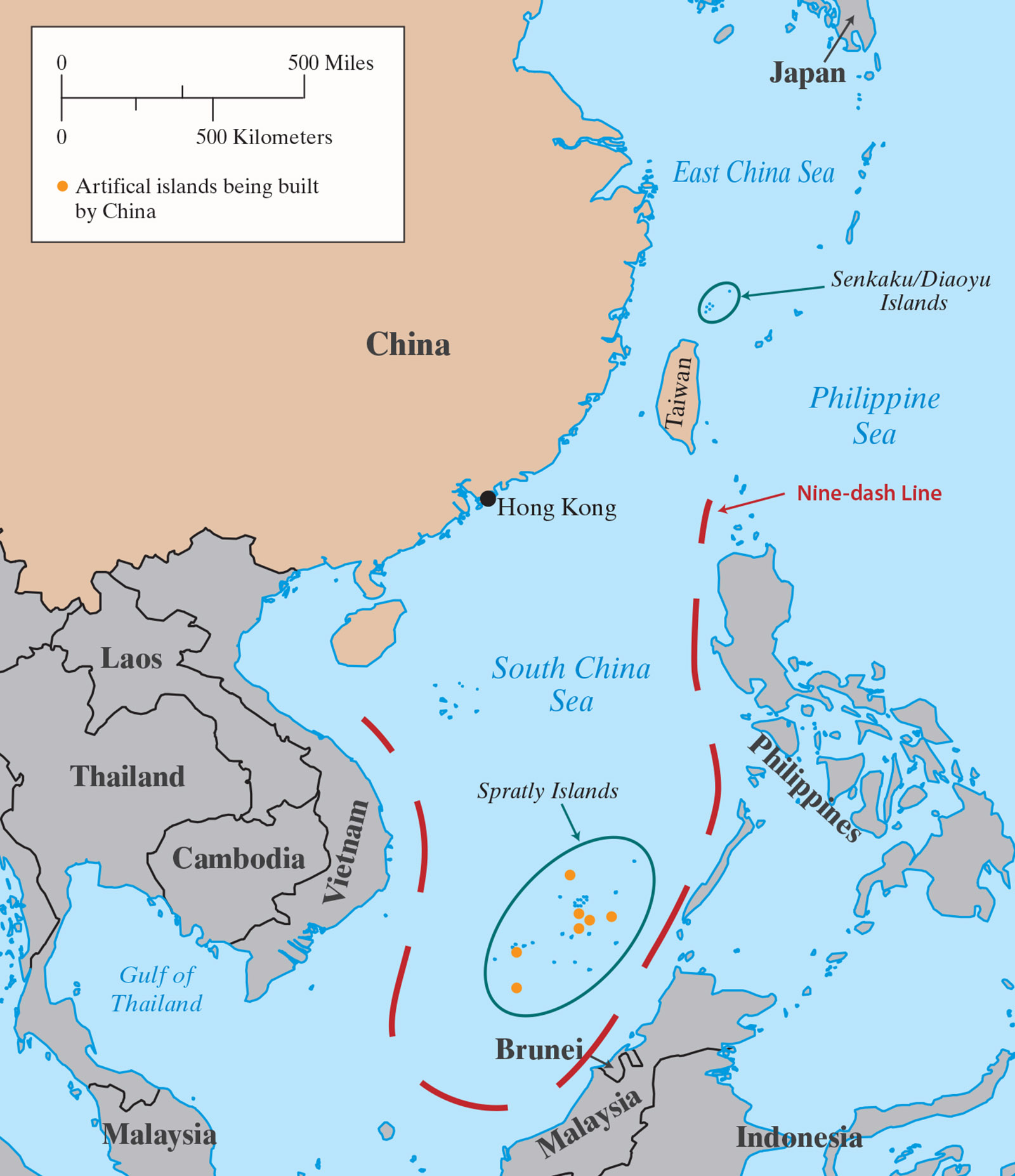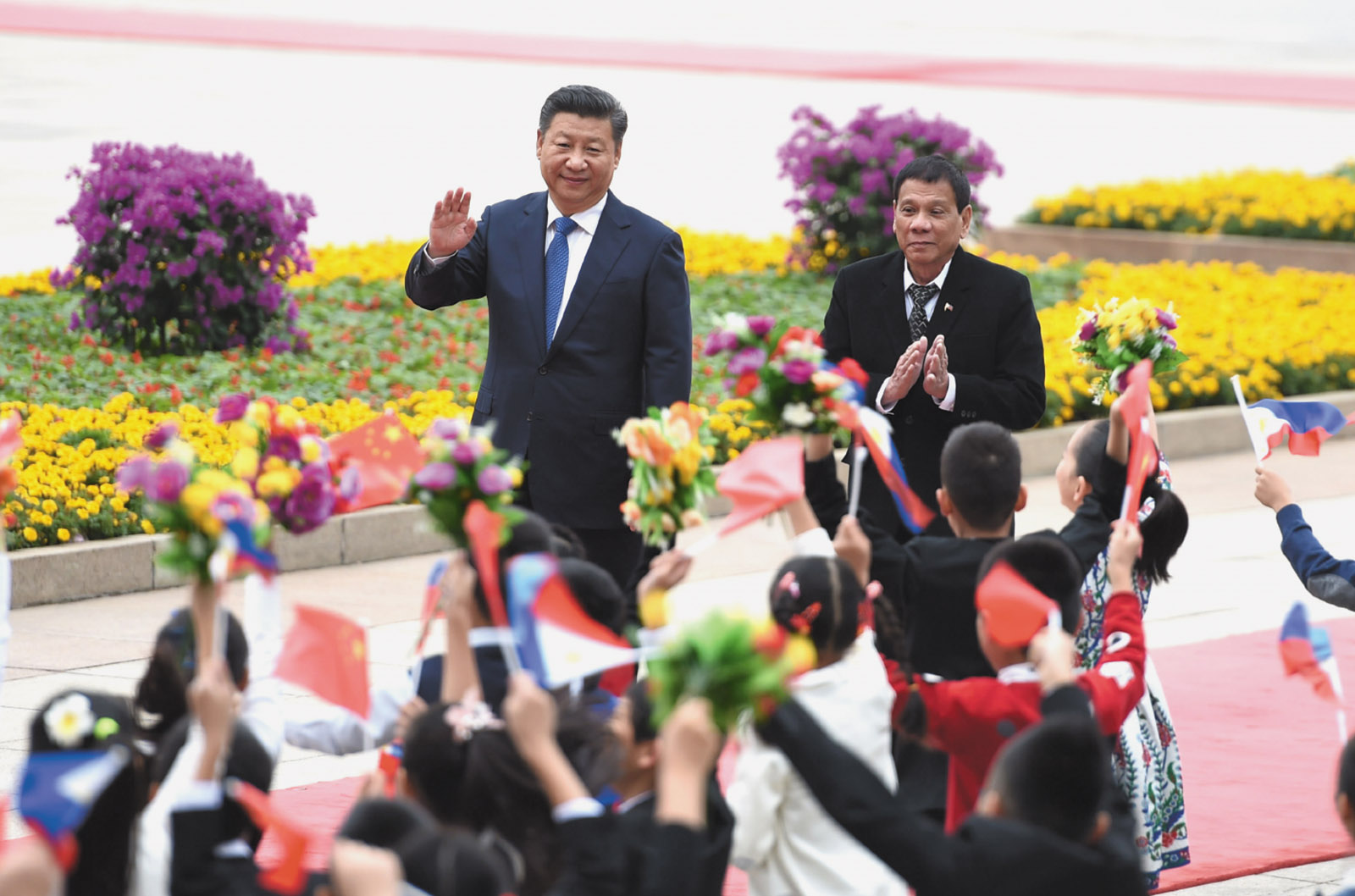China’s influence in the world has become a persistent theme of these early days of the Donald Trump era. During his campaign, Trump portrayed China (not entirely incorrectly) as the leading malefactor in the politics of international trade—holding its currency down in order to pump out exports, while making it hard for foreign companies to enter its own vast market. Then, after his victory, Trump as president-elect came up with the provocative idea of accepting a congratulatory phone call from the Taiwanese president. His intent seemed to be to knock the Chinese off balance in hopes of starting trade negotiations on a more favorable footing. Predictably this angered Beijing, which believes that it should control Taiwan, the self-governing island that Western nations, in deference to China, have long excluded from full diplomatic recognition.
But upon taking office, Trump executed a quick about-face. During a phone conversation in early February, Trump told Chinese President Xi Jinping that his administration would abide by the One China policy, a vague formulation that China interprets to mean that Taiwan is part of China. In other words, the new administration caved. The score: The Art of War 1, The Art of the Deal 0.
One obvious conclusion is that the new administration has, as on so many other matters, shown itself to be a diplomatic dilettante. If the US really wanted to challenge the fiction that Taiwan has no choice but to unite with mainland China, then it would have needed a real strategy and not just bluster. Similarly, the new administration withdrew from the Trans-Pacific Partnership trade deal, one widely regarded as favorable to the US, without any backup plan. Devoid of substance, the administration’s forays into China policy have left the US weaker in its dealings with China, and looking less reliable to China’s neighbors.
Seen from a broader perspective, however, a less obvious and more interesting point emerges: China is now such a strong regional power, and has such a focused strategic vision, that some sort of US eclipse in East Asia is inevitable, regardless of who is in office in Washington. The first part of this point is easy to understand: forty years of rapid economic growth have allowed the Communist Party to modernize its military. That’s made it a budding world power. But what of the second part: the strategic vision? What pushes China to want to dominate this part of the world? What is the ideology driving not just Xi and his team, but successive Chinese leaders who have looked out over East Asia, bided their time, and built their strength until now, in the second decade of the twenty-first century, they suddenly assert it?
Howard French helps answer these questions in his provocative but clearly argued book Everything Under the Heavens. The title comes from the Chinese phrase tian xia, which refers to China’s historic view of the world: China sitting in the middle as the sole possessor of civilization, with its much smaller neighbors on its periphery at best able to approach this perfection by imitating it. In French’s view, Beijing is reasserting these ancient prerogatives and means of controlling its neighbors. The Trump administration’s foreign policy helps China by shunning alliances and trade deals that might have helped East Asia’s smaller countries resist China’s pull. But overall, China’s growing power has mainly resulted from a reassertion of traditional worldviews coupled with the newfound might to realize them.
French’s book is filled with memorable sentences, such as: “Soon after 2010, China began a concerted push toward something that, if it succeeds, will constitute the biggest grab of territory the world has seen since Japan’s imperial conquests of the 1930s and 1940s.” Although readers might initially draw back at such formulations, upon reflection they are not only defensible but may be closer to reality than the “strategic ambiguity” approach to China favored by many in the foreign policy establishment, according to which we should avoid drawing large conclusions when discussing the Chinese government’s aims (and our own) because doing so would lead to disputes—better to kick the can down the road than to deal with troublesome reality.

Indeed, recent events bear out the need for clarity of thought and expression. For the past few years, China has methodically overrun its neighbors’ interests no less brutally than Russia has in Eastern Europe. This has not gone unnoticed but hasn’t caused quite the same level of alarm in foreign capitals. One reason might be trade. Unlike Russia, China is a crucial economic partner for many Western countries—for example, in 2016 it overtook the United States and France to become Germany’s biggest trading partner.
Advertisement
But part of the reason is also that Beijing’s intentions have been much harder to gauge. Russia clearly wants to annex lands it sees as its historic territory—Crimea, for example. But China? Some analysts suggest that its primary aim is not to dominate the coastal waters surrounding it. There must be more benign reasons, such as economic ones—it just wants the gas and oil under those waters and will eventually cut a deal to get access to them.
In fact, as French points out, China’s leaders really do want to control these areas. This is borne out by recent events. In 2010, China launched its first foray by sending fishing boats (which are pawns answering to the Chinese navy) into Japanese waters. The goal was to assert Chinese claims over the Senkaku—or in Chinese, the Diaoyu—Islands. The Japanese navy responded by seizing one of the boats, in what became the beginning of a series of feints and thrusts between the two countries.
Met with a forceful response—Japan has the most advanced navy in East Asia—the Chinese leadership pivoted southward toward weaker neighbors, such as Vietnam, Malaysia, and the Philippines. There it began its most audacious move, one that the international community has not been able to counter: building artificial islands and declaring them Chinese territory.
Between 2013 and 2015 it built more than three thousand acres of new land in the South China Sea by occupying and expanding shoals and reefs just off the coast of the Philippines into islands big enough to support radar stations, runways, and docks for its growing navy. In the Spratlys alone it built 1.1 square miles (or about seven hundred acres) of new land; all the original islands and reefs in that island chain only covered two square miles.
Along with this building campaign has been Beijing’s novel—contemptuous might be a better word—interpretation of the law of the sea. First, the Chinese government violated any accepted understanding of maritime law by declaring the reefs and shoals to be sovereign territory. (These sorts of partially submerged rocks are not legally claimable land.) Then it claimed the waters around them as its exclusive economic zone. Finally it declared that economic zones of control are virtually the same as territorial waters, giving it the right to chase off any ship that passes through. The effect has been to make the South China Sea into China’s South Sea. This means more than Beijing being the dominant power in the region; it wants to control these waters as if they were an inland lake.
China’s leaders have not directly discussed these actions, but broadly say that their claims are based on history. The argument is simple: because Chinese ships once sailed here, the reefs and shoals are Chinese. But as French puts it:
These historical claims are not worth exploring because of any legal power they might possess. Almost all non-Chinese experts agree that claiming distant waters as one’s own “historic waterway” is not something that international law or conventions governing the sea either contemplate or permit….
They merit our attention instead because of how they speak to China’s ambivalence about the international system itself, and to the continuing resonance of a certain imperial perspective—tian xia.
This opens what for me was the most interesting part of French’s book: a look at the origins of this idea and how it manifested itself historically. French is not a historical determinist, but he sees China’s push to Southeast Asia as a “march to the tropics” that began millennia earlier with Chinese civilization moving southward from its origins in north-central China toward the Yangtze River and then down to the area around modern-day Hong Kong and Yunnan. Chinese rulers and officials eventually came to see three peripheries: an immediate zone that could be conquered, such as the modern-day province of Yunnan and its many hill tribes; an intermediary zone including Vietnam, Burma, and Siam, which could be assimilated; and the further reaches of Southeast Asia, which could be occasionally conquered but were too remote for effective control.
Vietnam and the people of what was then known as the Yue kingdom bore the brunt of this thrust to the south. After losing territory in present-day Guangzhou province (which is still known in China as Yue), Vietnamese rulers hunkered down in modern-day northern Vietnam and pushed south, conquering other peoples in what was essentially a mini-version of China’s imperialist mission. Vietnam’s rulers even had a Chinese-style name for neighboring Cambodia: “the pacified west.”
Advertisement
China’s last great gambit south was in the Ming dynasty, from the fourteenth to the seventeenth centuries, when it initially sent armadas to the South China Sea and beyond, most famously under the eunuch Zheng He. Like the Great Wall, Zheng He’s exploits were largely forgotten in China until Westerners discovered him and saw him as a Chinese Columbus or Magellan. Chinese nationalists in the twentieth century latched onto this, constructing a version of history that persists today—mainly that Zheng He was a peace-loving explorer who went to trade with the natives.
In fact, the historical record is clear that Zheng He’s ships were designed not to explore but to carry large armies that fought and bullied local governments into surrendering booty. As French argues, this makes China a classic gunpowder empire that pillaged territories by using new technologies that its neighbors hadn’t yet mastered.
What stopped China from more firmly controlling these areas—and essentially giving them their independence today—was domestic turmoil. The Ming court decided it was not interested in far-flung seas, instead concentrating on pressure from northern nomadic tribes that eventually conquered the Ming and set up the Qing dynasty in the mid-seventeenth century. The Qing also had little interest in lands beyond their coasts, but they did create an enormous land-based empire that China mostly still possesses today, including control over Xinjiang, Tibet, large swaths of historically Mongolian territory, and the northeast of the country, none of which had been under long-term Chinese control until the Qing. (Only modern-day Mongolia is now an independent state.)
This gives modern China a great land mass reaching deep into Central Asia—the equivalent, perhaps, of India controlling today’s Pakistan, Bangladesh, Nepal, and Afghanistan. But paradoxically, even though China ended up with generous modern borders, it still suffers from what scholars call the “frustrated state” narrative: that it was a loser in history. In the 1920s and 1930s influential writers like Liang Qichao bemoaned this loss. China, they felt, rightfully should have pursued Zheng He’s journeys and become a maritime empire.
This mattered to China’s modernizers—and today’s rulers—because they saw the world as built on sea-based empires and trade. So in 1947, the Chinese government (the Nationalists under Chiang Kai-shek) came up with the “nine-dash line,” a crude demarcation of China’s claims to the South China Sea that seemed to have been drawn with little more than chutzpah and a magic marker. It delineated China’s claims to all of the sea right up to the coastline of Vietnam, the Philippines, Malaysia, and Indonesia, as if they didn’t exist and didn’t deserve their own coastal territorial waters. Zheng He had been there, and that trumped the centuries of kingdoms and empires in those countries. Their history didn’t matter.
Unfortunately, this untenable claim is what successive governments have adopted and every schoolchild learns that this is China’s inalienable territory. At first China was hesitant and downplayed these claims—Mao didn’t care about these sorts of issues, while Deng was realistic enough to know that China was too weak to challenge its neighbors. But forty years after Mao’s death and twenty years after Deng’s own passing, China is now strong and its neighbors are divided and weak. Hence the push to fulfill China’s historic mission and recreate the imagined lost empire of Zheng He.
As French makes clear, these efforts didn’t start with Xi Jinping. As early as 2003, shortly after Hu Jintao took over from Jiang Zemin as the president of China, Beijing began underwater mapping of Japanese inner coastal waters without notifying Japan. A little over a year later, it sent a nuclear-powered submarine into Japanese waters. That was followed by the fishing trawler episodes, which occurred two years before Xi took office.
But Xi has pushed this vision more vigorously as part of his cornerstone project of “the great rejuvenation of the Chinese nation.” Part of this is recapturing lost territory, but domestically Xi has also promoted traditional notions of patriotism and identity. Like his overseas adventures, these can be seen from a purely realpolitik point of view as a way to bolster domestic support at a time of falling economic growth. Yet this would be too narrow an interpretation. Instead, they are part of a greater national project of restoring the lost center of gravity to Chinese society, one that sees the state not as a provider of services or citizens’ rights, but as a guarantor of China’s rightful place abroad and shared values at home.
Unfortunately, this is an exercise based on recreating a myth. Chinese leaders might have fancied that other states eagerly awaited Zheng He’s ships and his civilizing gifts. But the record suggests that they kowtowed to the Chinese emperor as a strategy of survival. And even if Zheng He did force recalcitrant rulers to tremble and obey, that is not the basis of a viable international order.
This isn’t to say that relations were always bad or only based on violence and power. On the contrary, reality was much more interesting, as I learned during a recent visit to Singapore. There I had the chance to spend some time with the Chinese religious studies scholar Kenneth Dean of the National University of Singapore. Dean has devoted his career to studying how Chinese societies are organized, focusing first on the social life of coastal Chinese communities in Fujian province. He was struck by how contemporary religious life in one province, Fujian, was rebuilt after the Cultural Revolution with huge help from overseas Chinese in Singapore, Malaysia, the Philippines, and Indonesia. They brought back not only money but knowledge that had been lost, helping to recreate ritual life in these areas.
That sent Dean across the oceans to learn more about these overseas ties. He has found that this interaction isn’t new; it has been going on for centuries and has greatly enriched Chinese life. For example, Chinese traders had to shed some of their culture’s extreme patriarchalism when they came into contact with Malay culture. Greater emancipation for women then filtered back into southern Chinese coastal communities. Southeast Asia became a giant laboratory for new ideas that have mutually enriched its myriad cultures. They also helped make areas like southern China more independent of central control, giving them autonomy and the flexibility that today make them motors of China’s economy.*
China’s current approach threatens these fragile but fertile networks. By centralizing at home and pushing hard abroad, the Chinese state is stifling the cultural ferment and independent interactions that underpin true influence and innovation. Some countries, like Thailand, the Philippines, and Malaysia, have been so overwhelmed by China’s sudden dominance that they are now led by servile leaders eager to appease it at any cost. (French wrote his book before Rodrigo Duterte’s election as president of the Philippines but the country’s inability to deal with China was already so clear that he writes of the failure of the Filipino political class.)
Far wiser would be a China that has a hands-off approach to these countries and waterways. Given China’s size, it will inevitably dominate the region, but could do so more magnanimously—and arguably at greater strategic benefit to itself—for example by jointly drilling for oil and gas, and declaring the islets and reefs to be under international or some sort of joint jurisdiction, instead of pushing a hard-line nineteenth-century view of sovereignty and national greatness. This could help lead to a new kind of tian xia, one in which people are equal under heaven, instead of arranged hierarchically under new emperors and overlords.
-
*
These ideas are discussed in much greater depth and sophistication in Kenneth Dean, “Ritual Revolutions: Temple and Trust Networks Linking Putian and Southeast Asia,” Cultural Diversity in China, Vol. 1, No. 1 (2015). ↩





